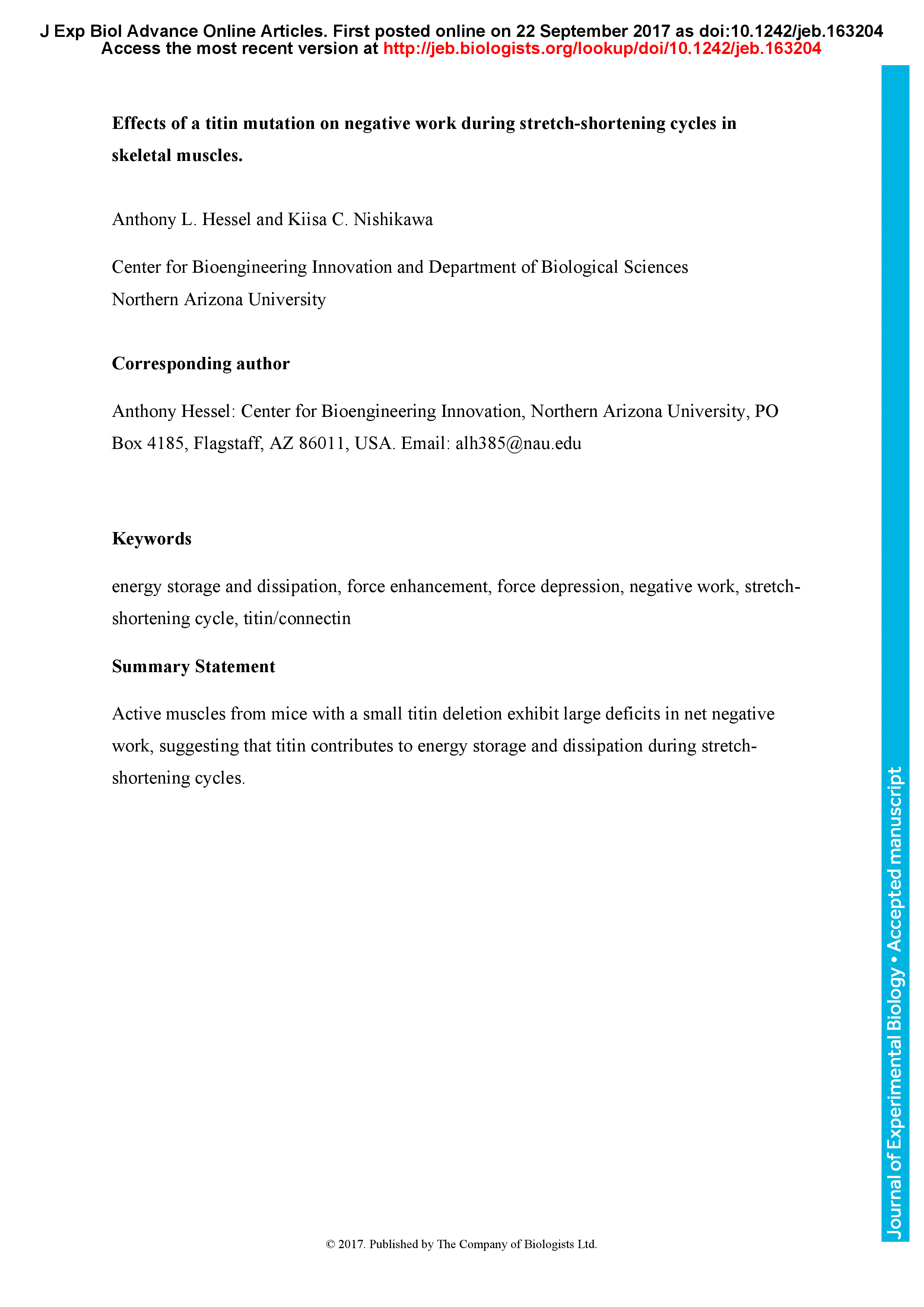Negative work occurs in muscles during braking movements such as downhill walking or landing after a jump. When performing negative work during stretch-shortening cycles, viscoelastic structures within muscles store energy during stretch, return a fraction of this energy during shortening, and dissipate the remaining energy as heat. Because tendons and extracellular matrix are relatively elastic rather than viscoelastic, energy is mainly dissipated by cross bridges and titin. Recent studies demonstrate that titin stiffness increases in active skeletal muscles, suggesting that titin contributions to negative work may have been underestimated in previous studies. The muscular dystrophy with myositis (mdm) mutation in mice results in a deletion in titin that leads to reduced titin stiffness in active muscle, providing an opportunity to investigate the contribution of titin to negative work in stretch-shortening cycles. Using the work loop technique, extensor digitorum longus and soleus muscles from mdm and wild type mice were stimulated during the stretch phase of stretch-shortening cycles to investigate negative work. The results demonstrate that, compared to wild type muscles, negative work is reduced in muscles from mdm mice. We suggest that changes in the viscoelastic properties of mdm titin reduce energy storage by muscles during stretch and energy dissipation during shortening. Maximum isometric stress is also reduced in muscles from mdm mice, possibly due to impaired transmission of cross bridge force, impaired cross bridge function, or both. Functionally, the reduction in negative work could lead to increased muscle damage during eccentric contractions that occur during braking movements.
Effects of a titin mutation on negative work during stretch-shortening cycles in skeletal muscles
Currently Viewing Accepted Manuscript - Newer Version Available
- Split-screen
- Views Icon Views
- Open the PDF for in another window
-
Article Versions Icon
Versions
- Version of Record 15 November 2017
- Accepted Manuscript 01 January 2017
- Share Icon Share
-
Tools Icon
Tools
- Search Site
Anthony L. Hessel, Kiisa C. Nishikawa; Effects of a titin mutation on negative work during stretch-shortening cycles in skeletal muscles. J Exp Biol 2017; jeb.163204. doi: https://doi.org/10.1242/jeb.163204
Download citation file:
Advertisement
2023 JEB Outstanding Paper Prize shortlist and winner

The JEB Editors are delighted to announce the shortlisted authors for the 2023 JEB Outstanding Paper Prize. Read the winning paper - Tiny spies: mosquito antennae are sensitive sensors for eavesdropping on frog calls - by Hoover Pantoja-Sanchez and Brian Leavell from Ximena Bernal's lab at Purdue University, USA.
JEB Science Communication Workshop for ECRs

If you’re an early-career researcher interested in science communication and are attending the SEB Annual Conference in Prague this summer, come a day early and join the JEB Editors at a sci comm workshop to learn the key writing skills needed to promote your research to a broad audience beyond your peers (1 July at 14.30-17.30). Places are limited to 24 attendees, and applicants should apply through the SEB registration page by 30 April 2024.
Bridging the gap between controlled conditions and natural habitats in understanding behaviour

Novel technologies enable behavioural experiments with non-model species, in naturalistic habitats and with underexplored behaviours. In their Commentary, Scholz and colleagues discuss how to obtain a deeper understanding of the natural ecology and lifestyle of study animals.
Beluga metabolic measures could help save species

To help save animals from extinction, it’s important to understand what each species needs to survive. This led Jason John et al. to measure the metabolic rates of captive belugas to develop a ‘fish calculator’ showing that the whales need to eat ~23 salmon per day.
ECR Workshop on Positive Peer Review

Are you an ECR looking for tips on how to write concise, astute and useful manuscript reviews? If so, join the JEB Editors at a 2-hour JEB-sponsored Workshop on Positive Peer Review at the Canadian Society of Zoologists annual meeting in Moncton on 9 May 2024 at 13.00-15.00. There are 25 spaces for ECRs and selection is first come, first serve. To sign up, check the ECR Workshop box when you register for the CSZ meeting.



